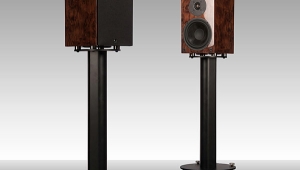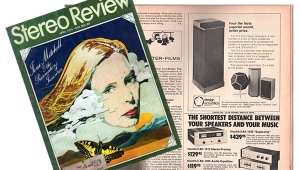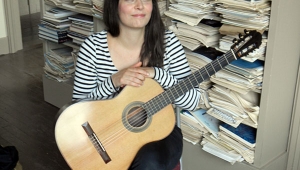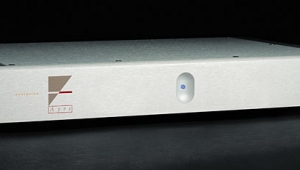| Columns Retired Columns & Blogs |
The Fifth Element #57 Page 2
ATC's SCM 11 and Aerial Acoustics' 5B (which I wrote about in June) are variations on the same theme—sealed-box, stand-mounted two-ways costing about $2000/pair—so it seemed reasonable to compare them.
The ATC SCM 11's cabinet measures 15" high by 8.3" wide by 9.8" deep, displaces 1220 in3, and weighs 17.6 lbs. The Aerial 5B measures 13" high by 7.9" wide by 10.8" deep, displaces 1109 in3, and weighs 22 lbs. So the ATC's cabinet is about 10% larger. Perhaps more important—and I keep making a point of this because I think it's both nonintuitive and often overlooked by audiophiles while shopping—the Aerial 5B's 7.1" mid/woofer has just about twice the surface area of the ATC SCM 11's 6" cone: 39.59 vs 19.63 in2. (Of course, this does not translate into twice as much bass.) ATC claims a sensitivity of 85dB for the SCM 11 vs Aerial's claim of 86dB for the 5B. Stated impedance is 8 ohms for the ATC vs 4 ohms for the Aerial. ATC claims low-frequency extension for the SCM 11 of 56Hz, –6dB; Aerial, 60Hz, –2dB, and 50Hz, –8dB. I'd have to call the specifications race a tie. In use, both speakers had the well-controlled, reasonably well-extended bass you hope for from a sealed-box design.
I mainly used a Peachtree Nova USB integrated amplifier, and a Luxman DU-50 universal player as a transport feeding the Nova's S/PDIF port via a 2m length of Kimber Kable's DV-30 cable. Speaker cables were Nordost Blue Heavens. I started with the 5Bs, playing some tracks I've recently been using in this search, then played the same tracks on the ATCs. Later, I paired the ATCs with other electronics, including the Luxman L-505u integrated amplifier, and the Carat I57, Arcam Mini, and Denon RCD-DX1 one-box CD receivers.
I used a Peachtree Nova USB integrated amplifier, and a Luxman DU-50 universal player as a transport feeding the Nova's S/PDIF port via a 2m length of Kimber Kable's DV-30 cable. Speaker cables were Nordost Blue Heavens. Later, I paired the ATCs with other electronics, including the Luxman L-505u integrated amplifier, and the Carat I57 and Denon RCD-DX1 one-box CD receivers.
Playing "Embraceable You," from Jane Monheit's Taking a Chance on Love (CD, Sony Classical SK 92495), what immediately became apparent was the ATC's more articulate upper midrange. The treble was under control—revealing but sweet. Hand in hand with the above was a slightly wider soundstage. I quickly came to the conclusion that the ATC SCM 11 was a choice as valid as the Aerial 5B, and that, even though the differences between them were not "night and day," most listeners will prefer one speaker or the other, with room acoustics and associated equipment being, as always, major contributing factors.
I then listened to "I Won't Dance," Monheit's duet with Michael Bublé, which has a brassy big-band style arrangement. Here was a surprise. I'd thought that Aerial's 5B was the dynamics champ in affordable standmounts, but oops—the SCM 11 upped that game. The ATC's dynamics were stunning—and at normal listening levels. The one concern I can note is that the treble seemed a trifle disconnected—in this setup.
On the phasing test on Stereophile's Test CD 2, the SCM 11's performance was excellent, with a very pronounced difference in soundstage width between the in-phase and out-of-phase samples. Similarly, on "Green Flower Street," from Donald Fagen's The Nightfly (CD, Warner Bros. 23696-2), whatever phasing trick he uses about 2:14 into the track has never sounded better defined. On the veneered apron of the SCM 11's front panel, below the driver-mounting baffle, there is a black ATC logo badge whose lettering is made from a holographic diffraction-grating material. Holographic—that should have been the tipoff. The SCM 11 earned its "Monitor" label.
Over a great deal of listening with a more than usual amount of changing of source and amplification components, and several recomparisons with Aerial's 5B, I came to the conclusion that the SCM 11 had a touch of the "smile EQ" tonal character I found in PSB's Imagine B—a slightly recessed mid-treble region—although not to that extent. I found the Aerial's upper midrange more neutral and natural, and the ATC to have a slight amount of extra energy in the upper midrange and lower treble.
Going directly from the Peachtree Nova to Luxman's thrice-as-expensive L-505u integrated amplifier and four-times-as-costly DU-50 disc player, it became immediately apparent that the SCM 11 readily benefited from better partners. With Monheit's cover of "Honeysuckle Rose," the treble was more integrated with the midrange than it had been through the Nova, the soundstage was larger and more solid, and there was more fine detail in the beginnings and endings of notes. The sound became at once more authoritative and more relaxed.
With "Embraceable You" there was a better sense of the space the classical guitar was recorded in. Subtle dynamic shadings in Monheit's voice, as in her performance of the wonderful song "Bill," were rendered more realistically with the Luxman duo. All of which makes me think that the Peachtree Nova's phenomenal powers of resolution are not matched by an equal measure of timbral refinement. That said, I must emphasize that I don't know of anything close to the Nova's price of $1199 that delivers as much performance and flexibility. To take just one of the many examples I noted while listening to the ATCs with the Peachtree Nova, Jennifer Warnes's humming on Leonard Cohen's "Bird on a Wire," from her Famous Blue Raincoat (CD, original edition on Cypress; 20th Anniversary Edition, with 4 extra tracks, on Shout Factory) was presented with a resolution that was surprising at these prices.
- Log in or register to post comments




































